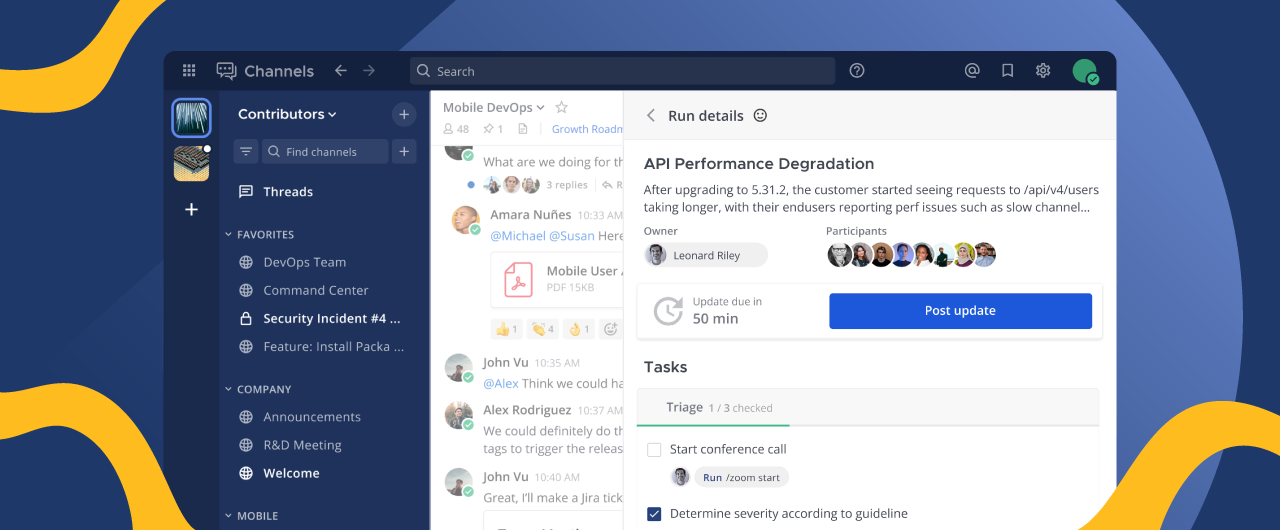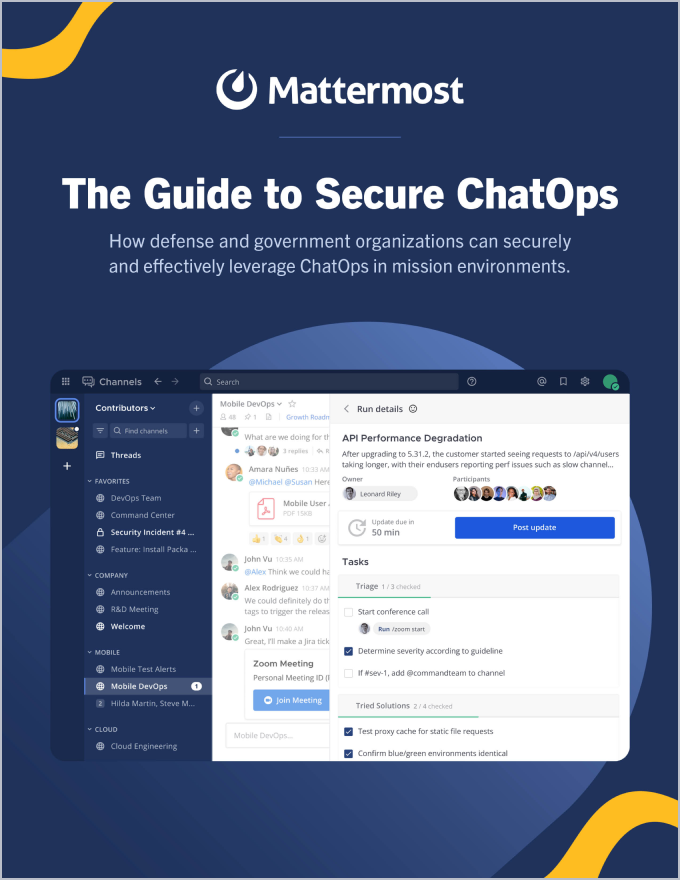
The Guide to Secure ChatOps
How defense and government organizations can securely and effectively leverage ChatOps in mission environments.
Modern defense and government operations rely on an intricate web of people, data, and workflows to get mission-critical work done every day. However, the complexity of those systems can make fast, efficient, and secure collaboration challenging. Information silos and communication gaps between critical toolchains and team members can slow workflows down, reduce clarity and impede the outcome of missions.
What is ChatOps?: The first step to accelerate Decision Advantage in mission environments
ChatOps is the practice of using chatbots, integrations, AI, and other tools within your chat platform to facilitate and automate operational tasks. With ChatOps tools, supercharge your chat platform, transforming it from a place to communicate into a hub for accelerating critical collaborative work. Many companies also invest in ChatOps platforms, as they enable easy integrations with other ChatOps tools and should include a chat client.
Why Is ChatOps Useful for Mission Environments?
In mission environments, implementing ChatOps can help teams in the field stay connected with the information, people, and tools that are essential to success.
The benefits of ChatOps include:
- Connecting all team members, mission partners, and other stakeholders in a single place.
- Centralizing collaboration around a shared console or command line for more effective communication.
- Accelerating the response times for time-sensitive workflows.
- Reducing manual effort involved in traditional voice communication and potential transcription errors.
- Capturing the history of mission team activity, system events, problems, and solutions.
Effective communication can save lives in mission operations. ChatOps can help your organization’s people do their jobs better, leading to more efficient resource use, more effective execution, and better overall outcomes.
Why implement ChatOps for your mission teams?
As government and defense organizations evolve to meet the demands of modern requirements, digital communication tools have become an indispensable part of mission operations. Chat platforms are now routinely used for managing mission operations, and ChatOps allows these teams to communicate and access information more effectively at the tactical edge.
ChatOps is more than just a novel approach; the Department of Defense has adopted ChatOps as a core component of the evolution of command and control initiatives, including Command, Control, Communications, Computers, Intelligence, Surveillance, and Reconnaissance (C4ISR) and Joint All-Domain Command and Control (JADC2).
In this guide, we’ll cover key considerations for implementing and scaling your organization’s ChatOps program. Keep reading to learn more about effective mission-critical ChatOps initiatives, common ChatOps challenges, and how to overcome them.
The chat tool you use is the medium in which your ChatOps practice will thrive.
Chat clients are today what email was 20 years ago: an essential part of communication workflows, and something that many organizations already have in place. But that doesn’t mean that every chat platform is the right fit for ChatOps. While general-purpose chat tools can be great for team conversations, they often lack the functionality and features necessary for tactical operations, including robust integrations and advanced security controls.
If you’re considering up-leveling your ChatOps practice — especially for high-stakes mission operations — it’s worth considering whether your chat platform can sustain a more robust practice and meet your organization’s unique needs. With that in mind, let’s examine some of the key requirements you should consider as you evaluate ChatOps solutions.
1. Integrations and extensibility
A great ChatOps platform should integrate well with every tool your team uses — particularly in-house tools. Look for ChatOps platforms that are open enough to enable customization to fit your team’s toolchains today and adapt to those they’ll need in the future.
ChatOps in Action
Unlocking the power of open source software for the U.S. Air Force
For organizations like the U.S. Air Force, security and compliance concerns severely limit their ability to quickly adopt and integrate new technologies. Teams risk being locked into approved vendors and missing out on critical innovations.
Platform One, the U.S. Department of Defense’s DevSecOps Enterprise Services team, adopted a new approach to software development services to enable the DoD to support continuous upgrades and new features with integrated cybersecurity testing on a much faster timeline and at a lower cost than the traditional “waterfall” cycle.
“As the DoD, we are not a very trusting enterprise by design,” says Master Sgt. Matthew Huston, the team’s chief of enterprise services, “What we do at Platform One is buy down our risk with vulnerability scans upfront as well as constant monitoring while the tools are in use. This allows us to move faster across more tools knowing that there is someone/something always watching.”
At the core of this new approach is leveraging open source and open core software, which has allowed Platform One to adopt new technologies rapidly and take advantage of cutting-edge solutions that were previously out of reach. Access to tools like Mattermost gives teams within the USAF greater ability to adopt, customize, and extend the software that is part of their ChatOps-driven mission operations.
2. Security and compliance
Bringing together tools and information from across different tools can be challenging, especially when considering the relative sensitivity of information on those systems. You want to ensure that data stays in the right hands and doesn’t accidentally end up on the wrong channels. To do that, look for tools that support the ability to granularly scope permissions and map that access to your pre-existing personnel management systems like LDAP to reduce the burden of user management and promote the tool’s ubiquity across staff machines. If your organization handles classified information, ensuring that your collaboration platform can operate at the appropriate data security classification levels required enables your team to communicate more effectively on that platform.
Deployment options are also essential to security for many organizations. Opting for a self-hosted system — or even one that can be deployed to an air-gapped environment — gives your organization an added layer of security for your most critical information.
3. User-friendliness and customizability
However effective they might be, incorporating new processes and tools can be challenging, especially if they disrupt existing workflows. Unsurprisingly, ChatOps initiatives often fall flat when they aren’t easy to use. Opt for tools that prioritize usability to help streamline the adoption process. As an extension of this, looking for tools that offer extensive customizability can offer a great degree of flexibility in how you use them, making them even more conformant to your team’s existing tools, workflows, and preferences.
4. Reliability and scalability
When evaluating solutions, consider the scope of use of your ChatOps tools. When your team is in the field, reliability is of the utmost importance. Selecting a solution that meets your team’s needs for connectivity and information availability is critical to success. For example, if your team needs to access information in a low-bandwidth environment, a traditional cloud-based chat tool may leave them without access to essential comms and context when they need it most.
Likewise, consider the immediate and long-term scalability of your ChatOps tool. Some tools only need to be used by a few team members to be effective. In other cases, ChatOps workflows might involve hundreds or thousands of team members.
Once a collaboration tool is embedded in your workflows, changing it out for something else can be painful. Ensuring that your platform can scale to fit your needs in the future — whether that’s dozens, hundreds, or hundreds of thousands of seats — will save you time, money, and effort in the long run.
ChatOps in Action
How the U.S. Air Force uses chat to securely share mission-critical documents
ChatOps has helped streamline pre-flight preparations for the U.S. Air Force (USAF) Air Mobility Command (AMC). Flight and mission paperwork must pass through four or five different offices for approval before every flight, which can be a slow and time-consuming process. In the past, aircrews received this information only about 30 minutes before flights, giving them limited time to review everything.
The AMC has begun using Mattermost Channels to share files securely via chat. The flight manager or command can share flight plans and mission packages directly with aircrew on their electronic flight bag approximately two hours before every flight, giving flight crews additional time before the mission to study and prepare. As a result of this streamlined process, they’ve been able to reduce flight-related fuel consumption and costs.
“For us, using Mattermost offers a huge benefit in mission velocity and safety. We found that also gave us a lot more time to fix cargo and fuel problems before the crew even shows up at the airplane,” says Major Justin Poole, Phoenix Spark Innovation Cell Director at Travis Air Force Base.
A ChatOps practice is about integrating, automating, and extending your workflows. But exactly what that looks like will vary from organization to organization and team to team. As you begin rolling out a ChatOps program for your team, consider these key use cases to increase your chances of success.
1. Creating a Command and Control hub
Integrating your tools into your chat platform is the most impactful way that ChatOps can improve your team’s workflows. Bringing together tools and data sources into a single source of truth helps keep information more discoverable and reduces friction to taking action. This results in one of the most significant benefits of ChatOps: creating a more focused work environment for your team.
The simplest form of integration is notification; one-way notifications get pulled into your chat system from platforms like ServiceNow, GitLab, and GitHub so that everyone in your channels has the context they need across different tools, without having to individually access those tools or log into them regularly. This can be especially beneficial for customer-facing stakeholders who might not have or need direct access to every developer tool but want to be able to track the status of a customer issue or outage from chat.
More sophisticated integrations can help enhance situational awareness and collaboration in complex environments. For example, integrating a chat platform with a Tactical Assault Kit (TAK) system enables mission operators in the field to leverage ChatOps to improve intelligence sharing and collaboration. Integrating that same platform with a mobile mesh networking platform could further address challenges associated with low-bandwidth communications and provide more resilient, decentralized connectivity.
2. Automating repetitive workflows
Repetitive, tedious workflows are more than just an annoyance for your team; they can waste valuable time when every minute counts, and create opportunities for errors to be introduced into critical workstreams. Using ChatOps to initiate, automate, and even complete workflows can offload repetitive tasks that don’t require intervention, helping the team reclaim the time previously spent on these tasks.
For example, the first few steps in kicking off a routine exercise for your team might be to send notifications to a few key stakeholders, set up a dedicated response channel, and pull a summary of background context into the channel. These tasks can be automated to ensure that your team spends less time on the initial logistics of coordinating their response, giving them more time to solve the problem.
ChatOps in Action
Air Mobility Command uses ChatOps to support largest-ever readiness exercise
Mobility Guardian 2023 (MG23) deployed 3,000 U.S. and Allied Forces personnel, with detachments from the United States, United Kingdom, Canada, Australia, New Zealand, France, and Japan. The effort enabled more than 15,000 U.S. and global forces to take part in extensive simultaneous exercises across the Indo-Pacific region.
Unscripted Mobility Guardian exercises require troops to think on their feet, quickly establish communication and other services, and dynamically adapt when operations don’t go as planned. AMC airmen can test out command-and-control (C2) applications, communications capabilities, and collaboration tools in contested, degraded, and operationally limited environments.
ChatOps enabled teams to leverage tools such as asynchronous communication channels and collaboration platforms to support mission activities. When AMC employed ChatOps for MG23, it utilized Mattermost.
Extending your team with bots, AI & beyond
We know that ChatOps can help connect the dots between your people and tools and take over some of your team’s time-consuming tasks. But beyond connecting the dots, ChatOps can help you build a bigger, better picture for your team with tools that extend your organization’s capabilities.
Bots are critical for extending the value of ChatOps by carrying out activities for you. They can interact with people, tools, and other bots to speed up processes even further. This is especially useful for processes that benefit from moving fast and have highly predictable workflows.
While artificial intelligence (AI) is still an emerging technology, it’s rapidly evolving and can push your workflows even further than what your team can do on their own. By summarizing information, identifying trends and potential issues before they occur, and even orchestrating workflows on your behalf, AI can help technical teams work more efficiently.
For example, one study found that when conversational AI chatbots are used, 61% of users can resolve their issues without having to contact support versus 35% with traditional chatbots. By adding AI-enhanced tools to your collaboration platform, you can empower your team to find the information and insights they need rapidly, enabling them to work with purpose and cover more ground.
Building a successful, effective ChatOps practice isn’t always easy, and many teams struggle to make ChatOps work well for them. Inefficient ChatOps workflows can negatively impact communication speed and efficacy, which can prevent mission teams from working effectively.
In this section, we’ll explore some of the most common blockers to establishing effective ChatOps initiatives — and what you can do to ensure mission teams have the right tools and processes in place to achieve successful outcomes.
1. Security and compliance concerns
ChatOps helps surface information from across a variety of tools. But that same accessibility that gives your team better information visibility can raise security and compliance concerns. could be exposed via ChatOps integration to employees who wouldn’t or shouldn’t have access to it otherwise.
What you can do:
- Opt for FedRAMP-compliant or self-hosted tools in a secure, air-gapped environment wherever possible
- Configure your chat system and integrations to ensure that sensitive information stays in the right hands and that no user has access to anything they shouldn’t, including non-human users

2. Setup and maintenance overhead
When they run smoothly, ChatOps integrations can be a true superpower for your team to accelerate mission operations, bringing essential context to the people who need it most, when they need it most. But setting up and maintaining those smooth connections can take ongoing effort, especially for highly customized systems. If you’re not careful, your team can easily end up replacing hours of manual tasks each week with hours of maintenance work, which more or less defeats the purpose. Be aware that integrations can be weak points in your ChatOps workflows if they aren’t robust enough; they can either break or not surface enough information to be useful.
Think of ChatOps just as you would any other infrastructure investment. When kicking off your ChatOps initiative, be sure to allocate the long-term resources you’ll need to maintain the health of the project overall — including security and information leaders in particular. Where possible, consider leveraging tools that are as flexible and integration-friendly as you can find. To make the most out of your ChatOps investments, you need to be able to configure integrations to your exact specifications and control them entirely. For this reason, it’s worth exploring open source tools that are fully customizable and provide complete source code access.
What you can do:
- Allocate dedicated resources to managing and maintaining integrations
- Avoid shadow IT — involve security and IT leaders in ChatOps administration
- Use open source and open core tools for a more flexible setup
3. Notification overload
While ChatOps initiatives can speed up workflows and automate repetitive processes, they can also introduce the problem of notification overload. Since ChatOps involves integrating multiple tools together, it can result in a constant stream of updates and alerts. It’s not uncommon for mature ChatOps environments to be flooded with messages from various bots and team members, which can get pretty noisy and overwhelming, making it harder for team members to focus on the most important matters.
As you begin developing your ChatOps program, pay attention to notifications and prioritize the most critical alerts. To avoid having your team drown in a sea of superfluous notifications, look for tools that are highly configurable and enable you to customize notifications to make it easier for team members to focus on the highest priority items. You may also want to begin tracking certain keywords passively to keep up to date with what’s happening without incurring an onslaught of notifications throughout the day.
What you can do:
- Think about notifications types and frequency as you begin deploying ChatOps workflows
- Use tools that enable you to customize notifications and alerts
- Track keywords passively to keep tabs on what’s going on without triggering a barrage of notifications
4. Scalability
As a ChatOps program continues to grow, scalability issues can pose significant challenges. When more users, tools, and teams are involved with ChatOps initiatives, the systems you rely on could experience performance degradation, slowing down response times and frustrating users. At the same time, ever-expanding ChatOps programs become more and more complex, which can make things difficult to maintain and manage.
What’s more, larger ChatOps programs can introduce additional security and compliance concerns; as the system becomes more intricate and more users gain access to mission-critical data, it can be difficult for an organization to ensure it’s meeting regulatory requirements. Scaling ChatOps can also result in integration and compatibility issues as connecting more and more tools becomes challenging.
To overcome scalability problems, make sure your ChatOps tools are built for performance at scale and are flexible by design. Teams should also automate as many processes as possible to streamline workflows. Additionally, they should make it a habit to review ChatOps environments on a regular basis to ensure they’re working efficiently and that no integrations are broken or causing performance issues.
What you can do:
- Choose tools that are built for performance at scale
- Automate repetitive processes
- Review ChatOps environments regularly

5. Training and adoption
Any time you’re rolling out a new initiative, expect some degree of resistance to the change in the status quo. In order to make the most out of your investments in ChatOps, you need to do everything you can to maximize adoption and train your team so they understand how to work effectively using it. After all, if users don’t understand the benefits of ChatOps and how it can help them work more effectively, they’ll be less likely to use it and will revert to the less efficient ways of working that they’re accustomed to.
As you begin planning your ChatOps program, spend time selling the new way of working to your team. Make sure they know why the organization is investing in ChatOps — cost savings, efficiency, and fewer errors, for example — and how ChatOps will make their lives easier.
Once they’re on board, roll out an initial comprehensive training to ensure every team member is familiar with the fundamentals of ChatOps. After that, hold regular freshers — once a quarter or twice a year — to keep the team informed and up to speed. You should also create a knowledge base or documentation that employees can reference to self-serve problems and issues on their own.
What you can do:
- Tell your team about your new ChatOps initiative, why it matters, and how it will make their lives easier
- Hold a comprehensive training session to educate all team members on all things ChatOps
- Schedule regular refreshers to address any knowledge gaps
6. Rigid workflows
One of the key challenges of workflow automation is that automation can create rigidity in workflows, which can decrease their usefulness as your processes, team, or requirements change. Looping in the right stakeholders to map out the right workflows in the first place is essential — as is keeping them aligned as processes change.
Even the best-designed workflows will change over time, so ensuring that your ChatOps system is flexible enough to adapt to changes as needed is also key. Conducting routine audits of critical automated workflows regularly can help keep them working efficiently, making it that much easier for you to achieve your ChatOps goals.
Unfortunately, even for the most innovative organizations, there can be a fair amount of inertia when it comes to changing processes and workflows. Keeping tools user-friendly and documentation up-to-date can help employees navigate problems with relative ease.
What you can do:
- Ensure tools are user-friendly
- Keep documentation up-to-date and useful
- Start small and scale

As technology continues to evolve and take a more central role in tactical and operational work, developing the right practices and systems to enable your team to work effectively and efficiently is key.
Remember that one of ChatOps’ biggest advantages isn’t replacing human operators, but helping them do their jobs better. From automating routine workflows and leveraging AI to enhance context around essential tasks, the goal of ChatOps is to create an environment that optimizes efficient, effective processes for the people on your team. Investing in ChatOps can help ensure that your team can make informed decisions and move quickly and securely in the highest-stakes situations.
Government and defense organizations trust Mattermost for secure ChatOps
As a secure collaboration solution designed to accelerate mission-critical ChatOps workflows, Mattermost offers the resiliency, reliability, and privacy that mission teams require.
More and more tactical teams within the defense and government sectors are choosing Mattermost for ChatOps for a variety of reasons:
- Deployment flexibility. Mattermost can be deployed anywhere, including on-premises in your own data center, in a private cloud, or even across air-gapped networks. Deploy Mattermost however you like and implement the security controls that are most appropriate for your environment.
- Data sovereignty. Mattermost gives you complete control over your data and enables you to deploy artificial intelligence safely and securely while ensuring your most sensitive information stays protected at all times.
- Customization. As an open core solution, Mattermost provides complete source code access, enabling security teams to review every single line of code and adjust the platform however they want to build the perfect tool for the job.
- Technical workflow functionality. Mattermost delivers a slew of features technical teams require, including topic-centric 1:1 and group discussions, slash commands, voice and screen share, custom emojis and emoji reactions, Markdown support, and more.
- High availability. ChatOps tools aren’t helpful if they’re unreliable. Mattermost offers high-availability clusters with redundancy. In the event a component of the system fails, the service is not interrupted, ensuring ChatOps workflows continue humming along.
Want to learn more? Contact our experts for a custom demo and learn how your team can achieve better ChatOps workflows with Mattermost.






